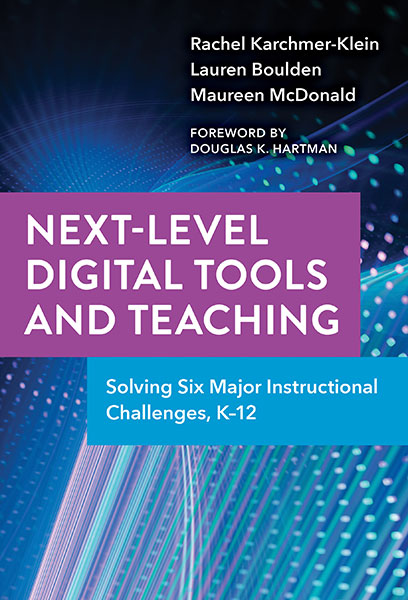Professors: Request an Exam Copy
Print copies available for US orders only. For orders outside the US, see our international distributors.
Rachel Karchmer-Klein, Lauren Boulden, Maureen McDonald
Foreword by: Douglas K. Hartman
Publication Date: March 14, 2022
Pages: 144

What we have learned from the many challenges of online teaching and learning during the COVID-19 pandemic is the focus of this authoritative resource. Featuring teachers’ experiences and classroom examples, the authors examine what’s needed and what works in order to help educators improve current models of technology-integrated instruction in their schools and districts. With a focus on digital tools and planning for any setting, the text provides ready-to-use help for designing technology-integrated lessons, building and managing community, selecting the best digital tools for particular tasks, increasing student engagement, and differentiating instruction. The text also includes a final chapter that looks at how leaders can support schoolwide coordination and infrastructure. Action items at the end of each chapter address the specific needs of individuals, teams, and schools to help them shift from reflection to actual implementation, encouraging collaboration and accountability. Next-Level Digital Tools and Teaching is applicable to teaching and learning in face-to-face, online, or hybrid K–12 classroom settings.
Book Features:
Rachel Karchmer-Klein is an associate professor at the University of Delaware and the author of Improving Online Teacher Education. Dr. Karchmer-Klein provides professional development to institutes of higher education, public school districts, and private schools. Lauren Boulden is a digital learning resource teacher and former middle school teacher in the Caesar Rodney School District in Delaware. Maureen McDonald is an instructional coach and former first-grade teacher in the Appoquinimink School District in Delaware.
“Whether utilized as a foundation for theoretical reference or an actionable guide for teaching in practice, educators, teacher students, and policymakers should find this work a helpful introductory guide to getting started on technology-integrated instruction.”
—Teachers College Record
“What I most admire about this book is the authors’ insistence on goal-driven coherence for technology-integrated instruction in the classroom, within a team, and across a district. Readers will emerge from their experience with the text asking themselves, ‘What are we trying to do for learners, and why?’”
—Kelly Chandler-Olcott, interim dean and Laura J. & L. Douglas Meredith Professor for Teaching Excellence, Syracuse University
“Whether it involves selecting digital texts and tools, promoting student access and engagement, teaching content grounded in evidence-informed practices, or envisioning district-level support, this book is a smart one-stop resource for technology-integrated solutions. Karchmer-Klein and her colleagues provide useful templates and planning guides alongside social media action items for teachers and districts to play an active role in building supportive educational communities together.”
—Julie Coiro, professor, The University of Rhode Island
“Guided by their synergistic planning framework, the authors of Next-Level Digital Tools and Teaching provide specific evidence-informed strategies to support effective technology integration in the classroom. This is an outstanding and timely resource for educators at all levels.”
—Blaine E. Smith, associate professor, University of Arizona
Contents
Foreword Douglas K. Hartman xi
Acknowledgments xiii
Introduction 1
Why This Book? 2
Synergistic Planning 3
Guiding Principles 4
Book Organization and Features 7
Conclusion 9
1. How Do I Teach the Attributes of Digital Text? 11
Literacy and Technology 12
Understanding Digital Text 13
Lessons to Teach the Attributes of Digital Texts 16
Assessing Your Understanding of Digital Text 23
Summary 26
Action Items 27
2. How Do I Design More Effective Technology-Integrated Instruction? 29
TPACK 29
Reflexive Pedagogy 30
Combining TPACK and Reflexive Pedagogy 31
Continuum of Technology Integration 32
The Role of Digital Text in Instructional Design 33
Steps to Designing More Effective Technology-Integrated Instruction 34
Examples of Technology-Integrated Lessons 37
Assessing Your Design of Technology-Integrated Instruction 37
Summary 42
Action Items 42
3. How Do I Select the Best Digital Tools for a Task? 45
Types of Digital Tools 46
Digital Tools in Action 50
Selecting the Best Digital Tools 52
Summary 56
Action Items 57
4. How Do I Increase Student Engagement When Using Technology? 59
Student Engagement 59
Build Community 61
Scaffold Self-Regulation 64
Summary 70
Action Items 71
5. How Do I Differentiate Technology-Integrated Instruction? 73
What Is Differentiated Instruction? 73
Differentiated Instruction and Digital Formative Assessment Tools 73
How Do I Use Digital Tools to Accommodate Different Learning Needs? 78
How Do I Use Digital Tools to Offer Choice to My Students? 80
Summary 81
Action Items 82
6. How Can My District/School Support Technology-Integrated Instruction? 83
Instructional Coherence 84
Develop a Vision for Technology-Integrated Instruction 85
Establish a Common Language 85
Set Directives to Advance Instructional Coherence 86
Five Areas of Directives 88
Steps to Developing Directives 93
Example of Directives in Action 94
Summary 96
Action Items 97
Appendix A: Description of Digital Tools Referenced in This Text 99
Appendix B: African Elephant Example 103
Appendix C: Semantic Feature Analysis Example 105
References 107
Index 115
About the Authors 121
Chapter 1
Multimodality Activity Document
Self-Assessment: Knowledge of Digital Text
Chapter 2
Technology-Integrated Instruction Lesson Checklist
Self-Assessment: Instructional Design
Technology Integration Planning Chart
Caitlin’s Digital Think Aloud Video of Lesson Design:
Chapter 3
Digital Tool Selection Document
Chapter 5
Maria’s Digital Think Aloud Video of Choice Board:
Chapter 6
Professors: Request an Exam Copy
Print copies available for US orders only. For orders outside the US, see our international distributors.